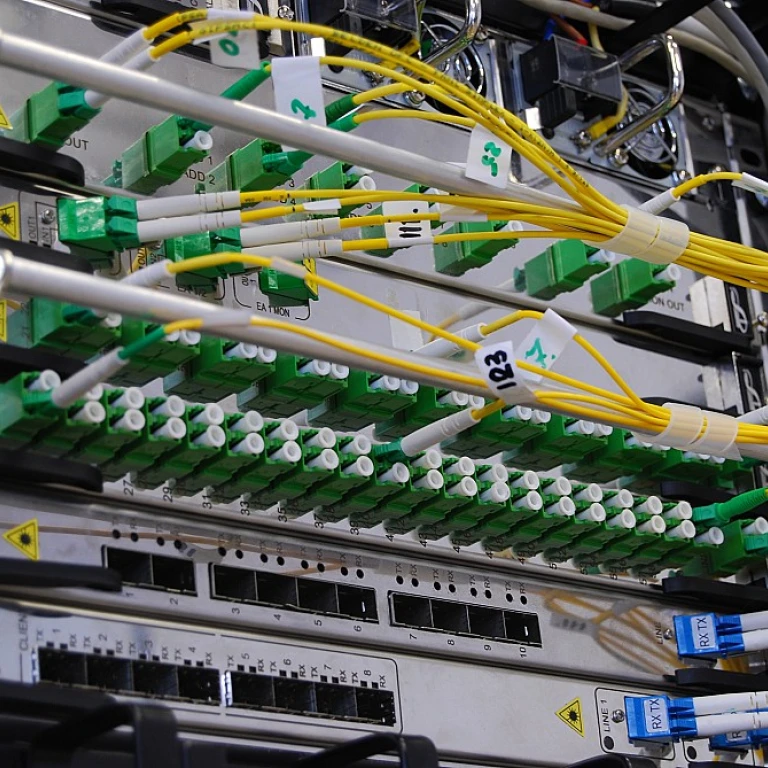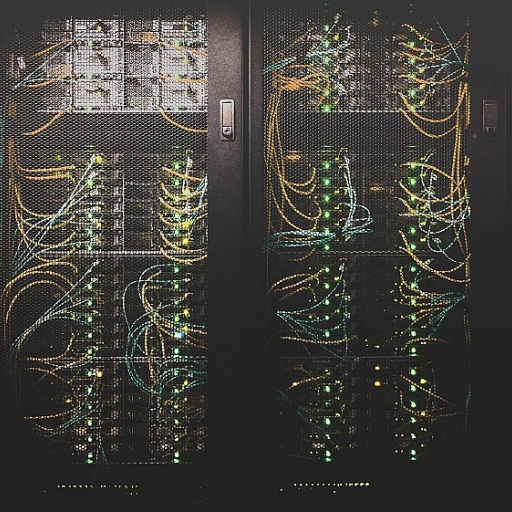
The Role of Software in Modern Supply Chains
The Digital Backbone of Supply Chains
In today's fast-paced world, the role of software in modern supply chains cannot be overstated. As consumer packaged goods (CPG) companies strive to meet ever-evolving customer demands, software solutions have become the digital backbone that supports efficient supply chain operations. These technologies enable companies to streamline processes, enhance inventory management, and optimize logistics.
Real-Time Data and Decision Making
One of the most significant advantages of integrating software into supply chain networks is the ability to access real-time data. This capability allows companies to make informed decisions quickly, reducing lead times and improving service levels. With real-time insights, businesses can better manage inventory levels, ensuring that they meet consumer demand without overstocking or understocking.
Enhancing Efficiency and Reducing Costs
Software solutions also play a crucial role in enhancing efficiency and reducing costs within supply chains. By automating routine tasks and optimizing network operations, companies can achieve significant cost savings. This optimization extends to various aspects of the supply chain, including demand forecasting, distribution, and delivery planning.
Improving Customer Satisfaction
Ultimately, the goal of any supply chain is to satisfy the customer. With advanced software tools, CPG companies can improve customer satisfaction by ensuring timely deliveries and maintaining high service levels. These tools provide the necessary chain intelligence to anticipate and respond to market changes, keeping customers happy and loyal.
For more insights on how software is transforming industries, you can explore the complexities of the advertising services industry.
Challenges in CPG Supply Chain Optimization
Addressing the Complexities of Supply Chain Networks
In the realm of consumer packaged goods (CPG), supply chain optimization is a multifaceted challenge. Companies are constantly striving to enhance efficiency and meet consumer demand while managing costs and maintaining high service levels. The complexities of supply chain networks often stem from the intricate web of logistics, inventory management, and distribution channels.
Inventory Management and Demand Forecasting
One of the primary challenges in CPG supply chain optimization is inventory management. Maintaining optimal inventory levels is crucial to avoid overstocking or stockouts, both of which can lead to increased costs and reduced customer satisfaction. Accurate demand forecasting is essential to align inventory with consumer demand, yet it remains a significant hurdle for many companies. The ability to predict demand in real time can greatly enhance decision making and improve inventory turnover.
Logistics and Distribution Efficiency
Logistics and distribution are other critical areas where CPG companies face challenges. Efficient planning and execution of delivery routes can significantly impact lead times and overall supply chain efficiency. Companies must balance the need for timely delivery with cost-effective logistics solutions. This requires a deep understanding of the chain network and the ability to adapt to changing conditions in real time.
Data-Driven Decision Making
The role of data in supply chain optimization cannot be overstated. Companies that leverage chain intelligence and real-time data analytics are better positioned to make informed decisions. However, integrating data from various sources and ensuring its accuracy and relevance is a complex task. Effective data management can lead to improved customer satisfaction and service levels by enabling companies to respond swiftly to changes in demand and supply chain disruptions.
For more insights on crafting strategies to tackle these challenges, explore our marketing framework for B2B tech companies.
Emerging Technologies Transforming Supply Chains
Revolutionizing Supply Chains with Cutting-Edge Technologies
In the rapidly evolving landscape of consumer packaged goods (CPG), emerging technologies are playing a pivotal role in transforming supply chain networks. These innovations are not only enhancing efficiency but also enabling companies to meet the ever-increasing demands of consumers. Let's delve into some of the key technologies that are reshaping the future of supply chains.
Artificial Intelligence and Machine Learning
Artificial intelligence (AI) and machine learning (ML) are at the forefront of supply chain transformation. These technologies empower companies to optimize inventory management and demand forecasting by analyzing vast amounts of data in real time. AI-driven chain intelligence tools provide insights that enhance decision making, reduce lead times, and improve service levels, ultimately boosting customer satisfaction.
Internet of Things (IoT)
The Internet of Things (IoT) is revolutionizing logistics and inventory management by providing real-time data on inventory levels and distribution processes. IoT devices enable CPG companies to monitor their supply chain networks with unprecedented accuracy, ensuring timely delivery and reducing costs. This technology facilitates seamless communication between different components of the supply chain, enhancing overall efficiency.
Blockchain Technology
Blockchain technology is gaining traction in supply chain management due to its ability to enhance transparency and traceability. By providing a decentralized ledger, blockchain ensures that every transaction is recorded in a secure and immutable manner. This not only improves trust among stakeholders but also streamlines processes, reducing the time and costs associated with traditional methods.
Robotics and Automation
Robotics and automation are transforming the way CPG companies handle logistics and inventory turnover. Automated systems are capable of performing repetitive tasks with precision and speed, freeing up human resources for more strategic roles. This shift not only increases efficiency but also reduces the risk of errors, contributing to smoother operations and improved customer satisfaction.
As these technologies continue to evolve, they will undoubtedly play an integral role in the future of supply chain management. Companies that embrace these innovations will be better equipped to navigate the complexities of the modern market, ensuring they remain competitive in the ever-changing landscape of consumer packaged goods.
Case Studies: Success Stories in CPG Optimization
Real-World Examples of CPG Optimization
In the ever-evolving landscape of consumer packaged goods (CPG), companies are continuously seeking ways to enhance their supply chain efficiency. By leveraging advanced software solutions, several organizations have successfully optimized their operations, leading to significant improvements in inventory management, logistics, and customer satisfaction.
Optimizing Inventory Management
One notable example is a leading CPG company that implemented a real-time inventory management system. This system allowed them to monitor inventory levels across their entire chain network, reducing excess stock and minimizing lead times. As a result, the company achieved a higher inventory turnover rate and reduced costs associated with overstocking and stockouts.
Enhancing Demand Forecasting
Another success story involves a retail giant that adopted advanced demand forecasting tools. By analyzing real-time data and consumer trends, they were able to predict demand more accurately, leading to improved planning and distribution strategies. This proactive approach not only optimized their supply chain but also enhanced customer satisfaction by ensuring product availability.
Streamlining Logistics and Delivery
A global CPG company focused on optimizing their logistics and delivery processes by integrating a comprehensive chain intelligence platform. This platform provided insights into their logistics operations, enabling better decision-making and reducing delivery times. The improved efficiency in their logistics network resulted in lower distribution costs and higher service levels.
Improving Customer Satisfaction through Network Optimization
Finally, a major player in the CPG industry successfully optimized their supply chain network by implementing a sophisticated network optimization tool. This tool helped them identify bottlenecks and streamline their operations, leading to faster delivery times and improved customer satisfaction. By enhancing their chain optimization efforts, they were able to meet consumer demand more effectively and maintain a competitive edge in the market.
Future Trends in Supply Chain Software
Anticipating the Next Wave of Software Innovations
As consumer packaged goods (CPG) companies strive for greater efficiency in their supply chain networks, the future of software in this domain is poised for transformative changes. The integration of advanced technologies promises to redefine how companies manage inventory, logistics, and overall supply chain operations.
Real-Time Data and Predictive Analytics
Real-time data analytics is becoming a cornerstone of supply chain management. By leveraging real-time data, companies can enhance demand forecasting and inventory management, reducing lead times and optimizing inventory levels. Predictive analytics allows for more accurate demand forecasting, enabling companies to better align their supply with consumer demand, ultimately improving customer satisfaction and reducing costs.
Artificial Intelligence and Machine Learning
Artificial intelligence (AI) and machine learning (ML) are set to revolutionize decision-making processes within supply chains. These technologies facilitate chain intelligence by analyzing vast amounts of data to identify patterns and trends that humans might overlook. This leads to more informed decision-making, enhancing network optimization and improving service levels across the board.
Blockchain for Enhanced Transparency
Blockchain technology is gaining traction as a tool for enhancing transparency and traceability in supply chains. By providing a secure and immutable record of transactions, blockchain can help companies ensure the authenticity of their products and improve trust with consumers. This transparency is crucial for maintaining high levels of customer satisfaction and ensuring compliance with regulatory standards.
Internet of Things (IoT) for Improved Connectivity
The Internet of Things (IoT) is playing a pivotal role in connecting various components of the supply chain. IoT devices provide real-time insights into the status of goods during transit, enabling companies to monitor and optimize their logistics operations. This connectivity helps in reducing delays and improving the efficiency of delivery processes.
Cloud-Based Solutions for Scalability
Cloud-based software solutions offer scalability and flexibility, allowing CPG companies to adapt quickly to changing market conditions. These solutions support seamless integration across different parts of the supply chain, facilitating better collaboration and communication among stakeholders. By adopting cloud-based systems, companies can enhance their supply chain management and improve overall efficiency.
In conclusion, the future of supply chain software is bright, with emerging technologies offering unprecedented opportunities for optimization and efficiency. By embracing these innovations, CPG companies can stay ahead of the competition and meet the ever-evolving demands of the consumer market.
Best Practices for Implementing Supply Chain Software
Strategic Planning and Clear Objectives
Implementing supply chain software effectively begins with strategic planning and setting clear objectives. Companies must define what they aim to achieve, whether it's improving inventory management, reducing lead times, or enhancing customer satisfaction. Clear goals guide the selection and customization of software solutions, ensuring alignment with business needs.
Data-Driven Decision Making
Utilizing real-time data is crucial for optimizing supply chain operations. Companies should leverage data analytics to gain insights into inventory levels, demand forecasting, and logistics. This data-driven approach supports better decision making, enabling companies to respond swiftly to changes in consumer demand and market conditions.
Integration with Existing Systems
For seamless operations, new software must integrate with existing systems. This includes ERP systems, inventory management tools, and logistics platforms. Integration ensures that data flows smoothly across the supply chain, enhancing efficiency and reducing the risk of errors.
Training and Change Management
Successful implementation requires comprehensive training for staff. Employees must understand how to use the new software effectively to maximize its benefits. Additionally, change management strategies are essential to address any resistance and ensure a smooth transition.
Continuous Monitoring and Improvement
Supply chain software implementation is not a one-time event. Companies should continuously monitor performance metrics and seek opportunities for improvement. Regular reviews help identify areas for optimization, ensuring that the software continues to meet evolving business needs.
Collaboration and Communication
Effective communication and collaboration across the supply chain network are vital. By fostering a culture of collaboration, companies can enhance service levels and customer satisfaction. Open lines of communication help address issues promptly and maintain a high level of efficiency in the supply chain.





-large-teaser.webp)








